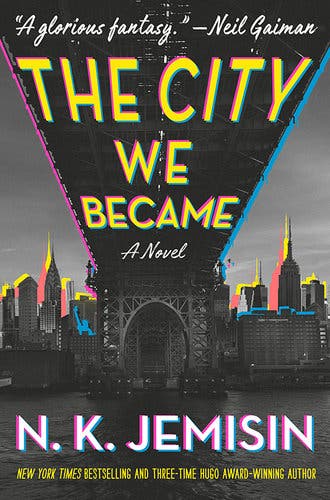[ Read an excerpt from “The City We Became.” ]
Structurally, “The City We Became” is largely a sequence of fast-paced set pieces, a series of encounters with the Enemy, with each embodied borough discovering new powers as readers discover their histories and personalities. In quick succession, we’re introduced to Manhattan, a young black man who surfaces from Penn Station with no memory; Brooklyn, a black, middle-aged city councilwoman and former rapper; Bronca, a tough-as-nails queer Lenape woman in her 60s; Padmini Prakash, a South Asian graduate student repping Queens; and Aislyn Houlihan, a sheltered young white woman with an abusive racist cop for a father, standing for Staten Island. Each of them squares off against the Enemy — incarnated in a white woman of varying age and features, but always dressed in white — with mixed results.

The book is rich and generous in a way that belies the easy analogues of the plot. The Enemy is white supremacy, police brutality, gentrification, but the book doesn’t waste time arguing that those things are evil (though it is a clever and satisfying reversal of the racist origins of H. P. Lovecraft’s mythos, recasting eldritch nastiness as white fragility). Instead, its main project is one of bridge-building, knitting communities together, showing how the embodied boroughs must overcome their own prejudices, their own irritations and limitations, to embrace and trust one another before they can win the fight.
In personifying four of the five boroughs as people of color, Jemisin flips the script on the film and television portrayals of New York that commonly relegate black and brown people to a kind of background flavor text. Crucially — and most affectingly — Jemisin locates New York’s identity in plurality and adoption rather than any kind of nativist purity. In the novel’s moving first chapter, Manhattan — arriving disoriented, amnesiac, overwhelmed — receives the kindness of strangers, people who see echoes of their past selves in him, who say they were new here once, too. New York “needs newcomers,” Jemisin writes, later adding, “There ain’t no one way to be a part of this city.” It’s a theme throughout the book, layered like so much mortar binding the boroughs’ disparate bricks. It wasn’t lost on me that of the five embodied boroughs, the one who comes to love the primary avatar of New York most fiercely and helplessly is also the newest transplant.
There is a tension, though, between the book’s argument and its world-building, a kind of background static distorting its otherwise clear lines. Jemisin makes an unsettling attempt at legitimizing the Enemy’s actions — a claim that when cities gain sentience, they weaken the fabric of reality and destroy entire universes. “Countless people, dying on countless worlds, and you don’t even notice,” the woman in white says. The book contends that she is actually fighting for her species’ survival. If Jemisin ended up dismantling this motivation, aligning it with the baseless hysterics of white supremacists denouncing “hybrid vigor” and white genocide, it would be one thing. But the destruction is acknowledged in the book, by multiple parties, as real.
Even more uncomfortably, the language the woman in white uses invokes the consequences of American imperialism: “Some try to fight you, flee to nearby realms in hope of sanctuary, even worship you in hope of mercy — but not one of those poor souls has a chance.” Mashing together the fear-mongering of white supremacy with legitimate criticism of America’s wars makes for an awkward allegory that occasionally undermines the book’s core assertions. While the whole project is enjoyably looser, faster, jokier than Jemisin’s other novels, passages like this make it feel less disciplined or anchored in its rhetoric than her fantasy worlds.
 EU News Digest Latest News & Updates
EU News Digest Latest News & Updates



